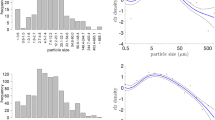Abstract
The usual convergence proof of the SMACOF algorithm model for least squares multidimensional scaling critically depends on the assumption of nonnegativity of the quantities to be fitted, called the pseudodistances. When this assumption is violated, erratic convergence behavior is known to occur. Three types of circumstances in which some of the pseudodistances may become negative are outlined: nonmetric multidimensional scaling with normalization on the variance, metric multidimensional scaling including an additive constant, and multidimensional scaling under the city-block distance model. A generalization of the SMACOF method is proposed to resolve the difficulty that is based on the same rationale frequently involved in robust fitting with least absolute residuals.
Similar content being viewed by others
References
Cooper, L. G. (1972). A new solution to the additive constant problem in metric multidimensional scaling.Psychometrika, 37, 311–322.
Defays, D. (1978). A short note on a method of seriation.British Journal of Mathematical and Statistical Psychology, 31, 49–53.
de Leeuw, J. (1977). Applications of convex analysis to multidimensional scaling. In J. R. Barra, F. Brodeau, G. Romier, & B. van Cutsem (Eds.),Recent developments in statistics (pp. 133–145). Amsterdam: North-Holland.
de Leeuw, J. (1984). Differentiability of Kruskal's Stress at a local minimum.Psychometrika, 49, 111–113.
de Leeuw, J. (1988). Convergence of the majorization method for multidimensional scaling.Journal of Classification, 5, 163–180.
de Leeuw, J., & Heiser, W. J. (1977). Convergence of correction matrix algorithms for multidimensional scaling. In J. C. Lingoes (Ed.),Geometric representation of relational data (pp. 735–752). Ann Arbor: Mathesis Press.
de Leeuw, J., & Heiser, W. J. (1980). Multidimensional scaling with restrictions on the configuration. In P. R. Krishnaiah (Ed.),Multivariate analysis, Volume V (pp. 501–522). Amsterdam: North-Holland.
Funk, S. G., Horowitz, A. D., Lipshitz, R., & Young, F. W. (1974). The perceived structure of American ethnic groups: The use of multidimensional scaling in stereotype research.Personality and Social Psychology Bulletin, 1, 66–68.
Guttman, L. (1968). A general nonmetric technique for finding the smallest coordinate space for a configuration of points.Psychometrika, 33, 469–506.
Heiser, W. J. (1981). Unfolding analysis of proximity data. Unpublished doctoral dissertation, University of Leiden.
Heiser, W. J. (1986).A majorization algorithm for the reciprocal location problem (Internal report RR-86-12). Leiden: University of Leiden, Department of Data Theory.
Heiser, W. J. (1987a).Notes on the LARAMP algorithm (Internal report RR-87-04). Leiden: University of Leiden, Department of Data Theory.
Heiser, W. J. (1987b). Correspondence analysis with least absolute residuals.Computational Statistics & Data Analysis, 5, 337–356.
Heiser, W. J. (1989). The city-block model for three-way multidimensional scaling. In R. Coppi & S. Bolasco (Eds.),Multiway data analysis (pp. 395–404). Amsterdam: North-Holland.
Hubert, L., & Arabie, P. (1986). Unidimensional scaling and combinatorial optimization. In J. de Leeuw, W. J. Heiser, J. J. Meulman, & F. Critchley (Eds.),Multidimensional data analysis (pp. 181–196). Leiden: DSWO Press.
Hubert, L., & Arabie, P. (1988). Relying on necessary conditions for optimization: Unidimensional scaling and some extensions. In H. H. Bock (Ed.),Classification and related methods of data analysis (pp. 463–472). Amsterdam: North-Holland.
Kruskal, J. B. (1964a). Multidimensional scaling by optimizing goodness of fit to a nonmetric hypothesis.Psychometrika, 29, 1–27.
Kruskal, J. B. (1964b). Nonmetric multidimensional scaling: A numerical method.Psychometrika, 29, 115–129.
Kruskal, J. B. (1977). Multidimensional scaling and other methods for discovering structure. In K. Enslein, A. Ralston, & H. S. Wilf (Eds.),Statistical methods for digital computers, Volume 3 (pp. 296–339). New York: Wiley.
Kruskal, J. B., & Carroll, J. D. (1969). Geometrical models and badness-of-fit functions. In P. R. Krishnaiah (Ed.),Multivariate analysis, Volume 2 (pp. 639–671). Amsterdam: North-Holland.
Kruskal, J. B., Young, F. W., & Seery, J. B. (1973).How to use KYST-2: A very flexible program to do multidimensional scaling and unfolding. Unpublished manuscript. Bell Laboratories, Murray Hill, NJ.
Roskam, E. E. (1972). Multidimensional scaling by metric transformation of data.Nederlands Tijdschrift voor de Psychologie, 27, 486–508.
Stoop, I., & de Leeuw, J. (1982).How to use SMACOF-1B (Internal Report). Leiden: University of Leiden, Department of Data Theory.
Torgerson, W. S. (1958).Theory and methods of scaling. New York: Wiley.
Young, F. W. (1972). A model for polynomial conjoint analysis algorithms. In R. N. Shepard, A. K. Romney, & S. B. Nerlove (Eds.),Multidimensional scaling, Volume I, Theory (pp. 69–104). New York: Seminar Press.
Author information
Authors and Affiliations
Additional information
I am grateful to Patrick Groenen and Rian van Blokland-Vogelesang for their help with some of the computations, and to the anonymous referees for their very useful comments.
Rights and permissions
About this article
Cite this article
Heiser, W.J. A generalized majorization method for least souares multidimensional scaling of pseudodistances that may be negative. Psychometrika 56, 7–27 (1991). https://doi.org/10.1007/BF02294582
Received:
Revised:
Issue Date:
DOI: https://doi.org/10.1007/BF02294582




